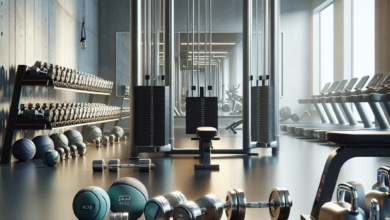Top Muscle Building Program for Natural Lifters!
Embarking on a quest to amplify muscle mass as a natural lifter demands a strategic approach that harmonizes intense training, meticulous nutrition, and sufficient rest. Unlike their enhanced counterparts, natural lifters must rely on their body’s innate capabilities, making the best muscle building program for natural lifters not only desirable but imperative for success. To Unlock Muscle Growth, one must understand the physiological mechanisms at play. Testosterone and growth hormone levels, along with the capacity for cellular repair, are pivotal in the natural muscle-building equation.
For natural lifters, emphasizing compound movements like squats, deadlifts, and presses is paramount. These exercises recruit multiple muscle groups, leading to greater hormonal responses and systemic growth. Equally important is the concept of progressive overload—incrementally increasing the weight or intensity of your workouts over time to continually challenge your muscles and induce hypertrophy. Additionally, tracking your progress and ensuring consistent training without overtraining is a delicate balance that must be maintained.
Whether you’re a novice or a seasoned gym-goer, Explore More at Muscle Theory for in-depth insights tailored to natural athletes. Our resources delve into cutting-edge routines and nutritional strategies that respect the body’s natural rhythms and recovery needs, setting you on the path to unlocking your full muscle growth potential without the aid of performance-enhancing substances.
Essential Training Principles for Hypertrophy

Building muscle mass hinges on adhering to several key training principles designed to stimulate hypertrophy—the increase in muscle size. Volume, intensity, and frequency are the trifecta of weightlifting variables that, when optimized, lead to significant gains for natural lifters. Volume refers to the total amount of work done, typically measured in sets and reps. A higher volume approach has been shown to be beneficial for hypertrophy, as it creates the necessary stimulus for muscle repair and growth.
Intensity, on the other hand, relates to the amount of weight lifted or the effort exerted during exercise. Training at a high intensity close to one’s one-repetition maximum (1RM) can trigger adaptation processes within the muscle fibers, leading to size and strength improvements. However, it’s crucial to balance intensity with adequate rest to prevent overtraining and allow for muscle recovery.
Lastly, frequency—or how often you train a muscle group—should be considered. For natural lifters, striking a balance between frequent stimulation and recovery time is essential. Training each muscle group 2-3 times per week allows for repeated muscle protein synthesis while providing time for recuperation. Attention to these principles, alongside proper technique and a focus on mind-muscle connection, will lay a solid foundation for natural athletes seeking hypertrophy through the best muscle building program for natural lifters.
Optimizing Nutrition for Muscle Gain

For natural lifters, nutrition is as critical as the workout itself when it comes to building muscle. The best muscle building program for natural lifters not only incorporates rigorous training but also emphasizes an optimized nutritional strategy that fuels muscle growth without the need for enhancements. A balanced macronutrient intake is paramount, with a focus on protein, carbohydrates, and healthy fats.
Protein is the building block of muscle, and consuming adequate amounts is essential for repair and growth. Natural lifters should aim for a protein intake of around 1.6 to 2.2 grams per kilogram of body weight daily. This can be sourced from lean meats, dairy, legumes, and plant-based alternatives. Carbohydrates are also essential as they provide the energy required for intense workouts. Complex carbs such as whole grains, vegetables, and fruits should constitute a significant portion of a lifter’s diet.
Healthy fats should not be neglected, as they play a role in hormone production, including testosterone, which is vital for muscle growth. Sources like avocados, nuts, seeds, and fatty fish contribute to a well-rounded diet. Additionally, hydration and timing of nutrient intake can further enhance muscle gains. Drinking plenty of water throughout the day and consuming a combination of protein and carbs post-workout aids in recovery and muscle protein synthesis. By tailoring these nutritional elements to individual needs and goals, natural lifters can create a conducive environment for muscle growth, integral to the success of their muscle-building journey.
Incorporating Rest and Recovery in Your Program

Rest and recovery are often the unsung heroes in the quest for muscle growth, particularly for natural lifters. Without adequate rest, even the best muscle building program for natural lifters can fall short, as it is during periods of rest that the body repairs and strengthens itself. Therefore, incorporating deliberate rest and recovery strategies is crucial for sustainable progress.
Active recovery days are vital and can include activities like light cardio, stretching, or yoga, which facilitate blood flow and can help speed up muscle repair without overtaxing the body. Equally important is sleep, with 7-9 hours per night being the gold standard for most adults. Sleep is a powerful anabolic state, during which growth hormone levels peak, contributing significantly to muscle repair and growth.
Another aspect of recovery is managing the intensity and volume of workouts. Overtraining can lead to fatigue and plateau, so it’s essential to listen to your body and include deload weeks when necessary. These are periods of reduced workout intensity or volume, allowing the body to recuperate fully.
Lastly, recovery modalities such as foam rolling, massage, or cold and heat therapies can aid in reducing muscle soreness and improving mobility. By valuing rest and recovery as much as the workouts themselves, natural lifters can avoid overtraining, reduce the risk of injury, and set the stage for consistent muscle growth over time.
Supplement Strategy for the Natural Athlete
While the core of any muscle building program should be focused on diet and training, supplements can play a supportive role in the regimen of a natural athlete. For those seeking the best muscle building program for natural lifters, understanding which supplements can aid in muscle growth, recovery, and overall health is key.
A high-quality protein powder can be invaluable for meeting daily protein requirements, especially post-workout when the muscle repair process is at its peak. Whey protein is a popular choice due to its high biological value and fast absorption rate, making it ideal for muscle recovery. For those who are lactose intolerant or prefer a plant-based option, soy, pea, or rice proteins are excellent alternatives.
Creatine monohydrate is another well-researched supplement that can enhance performance by increasing strength and power output during intense training sessions. It also aids in the recovery process by replenishing the body’s stores of ATP, the energy currency of cells.
Omega-3 fatty acids, found in fish oil supplements, are beneficial for their anti-inflammatory properties and can help in muscle recovery and joint health. Additionally, a high-quality multivitamin can ensure that the natural athlete covers any potential nutritional gaps, supporting overall health and well-being.
It’s important to note that supplements should never replace whole foods but rather complement a well-rounded diet. Always opt for supplements with a clear ingredient list and without unnecessary additives. Finally, natural lifters should always consult with a healthcare professional before adding new supplements to their routine to ensure they are appropriate for their individual health needs.
Monitoring Progress and Adjusting Your Program
For the natural lifter, tracking progress is essential to ensure that the best muscle building program for natural lifters is also the most effective one on an individual level. Consistent monitoring enables lifters to make informed adjustments to their workout routine, nutrition, and recovery strategies.
To accurately gauge progress, athletes should regularly measure and record various metrics such as body weight, body measurements, lift numbers, and even qualitative data like energy levels and overall well-being. Progress photos and strength performance videos can also serve as powerful visual tools to compare changes over time.
When progress stalls, as it inevitably will at times, adjusting the program becomes crucial. This might mean altering the volume or intensity of workouts, tweaking caloric intake, or ensuring that recovery periods are adequate to prevent overtraining. It’s also important not to rush changes; giving each adjustment enough time to manifest results is key to identifying what truly works for the individual athlete.
Another aspect to consider is periodization – planning variations in training intensity and volume over time. This approach helps to avoid plateaus, reduces injury risk, and can lead to sustained progress. Whether it’s through a linear, non-linear, or undulating pattern, periodization keeps the body guessing and adapting.
Lastly, remember that a successful program is not just about the numbers on the weights; it’s about improving your health and enjoying the process. If you’re ready to take your natural lifting to the next level and are looking for a community that shares your passion for fitness, Explore More at Muscle Theory, where you can find the support and resources you need for your journey.



